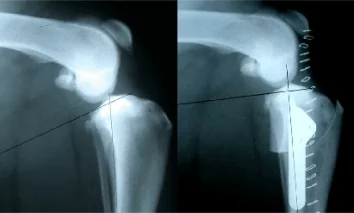Tibial Plateau Leveling Osteotomy (TPLO) Procedure in Pattersonville
TPLO Overview
Tibial Plateau Leveling Osteotomy (TPLO) is one of several advanced techniques used for the treatment of cranial cruciate ligament tears in dogs. This procedure was developed by the late Dr. Barclay Slocum, who is well known nationally as one of the pioneers of cat and dog surgeries.
The TPLO procedure involves cutting, and leveling the tibia in order to eliminate cranial tibial thrust, one of the forces responsible for cruciate ligament stress in the dog. With over 30 years of combined clinical surgical experience, our board certified surgeons have the training, experience and a history of successful outcomes performing the TPLO procedure.
While previous procedures often attempted to replace the function of the cruciate ligament, the TPLO procedure provides dynamic stability to the cruciate deficient stifle. At VSRC, we (and our patients) have been overwhelmingly satisfied with the clinical results achieved.
Dogs return to full, active status much more rapidly than in previously developed techniques. The TPLO procedure is also more effective at minimizing arthritic changes in the knee joint in comparison to more traditional types of repairs. Call us at (518) 887-2260 to schedule your pet’s procedure.
Is a TPLO right for my dog?
If your dog is suffering from undiagnosed hind limb lameness or a cruciate ligament tear, a thorough orthopedic examination by a board certified surgical specialist would help determine if he/she would benefit from the TPLO procedure. We recommend this procedure for dogs over 40 lbs. that have active, sporting, or working canine lifestyles. It is also recommended for young dogs that will benefit from minimized degenerative (arthritic) changes during the course of their lifetime. Regardless of the surgical procedure performed, there are several issues one should keep in mind:
- Any surgical procedures, especially those that require general anesthesia, have potential risks and benefits. Anyone who quotes you a 100% success rate should be viewed with skepticism.
- No single surgical procedure is right for every patient. A thorough pre-operative examination by a board certified specialist in surgery will help to ensure that you are getting the most appropriate recommendation for your pet.
- Have realistic expectations. If “Fido” wasn’t able to leap over fences before orthopedic surgery, he’s probably not going to after. Listen carefully to the prognosis that your surgeon offers. It is important that your expectations are in line with your surgeon’s.
TPLO Mechanics
Excessive tibial slope predisposes the canine to cranial cruciate ligament insufficiency.
Excessive slope of the tibial plateau can be compared to the pull of a wagon up an incline. Fig 3A. Rotating the tibial plateau relieves the tension on the cruciate ligament as illustrated by the rope and cart. Fig 3B.
The following illustrations are actual pre and post-surgical radiographs of a large breed canine who had the TPLO surgery performed at our facility. On the post-surgical radiograph, the plate and screws applied to the inside of the leg just below the knee joint appear as a solid white area.
On the post-surgical view, the radial cut and rotation of the bone is evident. This seemingly small change in the geometry of the knee greatly minimizes the dynamic forces placed on the joint. Thus, rotating the tibia is akin to putting the cart on a flat surface, relieving the tension (pull) on the rope. Fig. 3B above.
The “hash marks” on both the pre and post-operative x-rays are drawn by the surgeon to determine the amount of rotation achieved on the TPLO patient.
To learn more about TPLO surgery, give us a call at (518) 887-2260.






